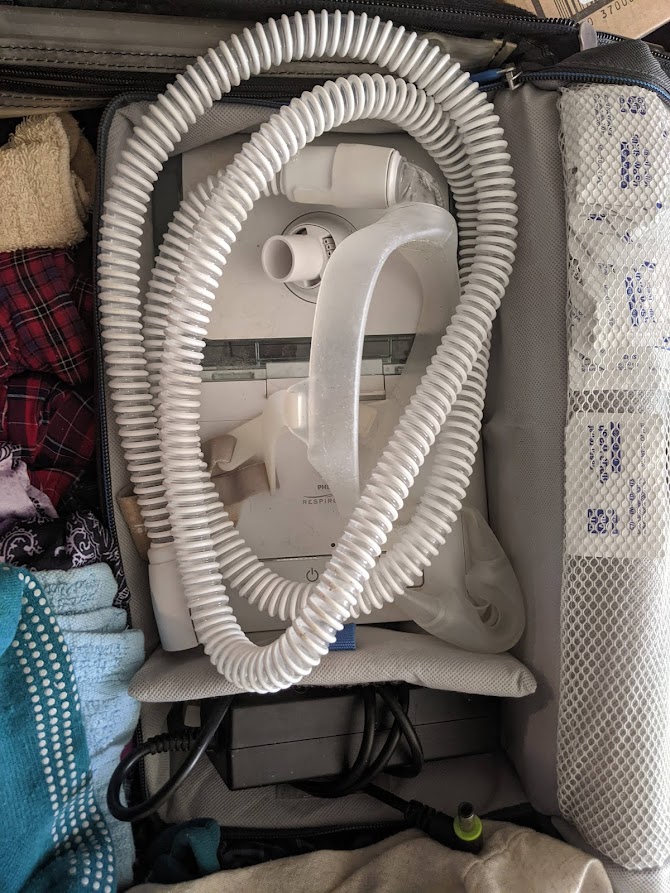Sleep apnea is a sleep disorder in which one stops breathing — anywhere from a few seconds to a few minutes– several times a night. Often this is accompanied by loud snoring. It isn’t generally considered a disability; it won’t get you a handicap parking spot in the airport parking lot, early boarding at the gate, or an accessible room in your hotel. But it can certainly be an inconvenience, especially when you’re sleeping anywhere that isn’t your own bed. Hotels, campsites, airplane seats, RVs… they all have their individual problems for traveling with sleep apnea. Most of them have to do with the equipment needed to treat it.
A common treatment for sleep apnea is a device called a CPAP (Continuous Positive Airway Pressure) machine, which keeps your airway open by blowing air into your nose and (possibly, depending on what type of mask you use) mouth. It’s a bit noisy, but it’s a lot quieter than snoring, and the white noise may even be soothing. There’s also a more up-to-date version called a BiPAP, which maintains lighter but still extant air pressure when you’re breathing out as well as higher pressure when you’re breathing in, so that you’re more comfortable while still keeping the airway open.
The first thing you have to worry about when traveling with a CPAP machine is that it needs electrical power. It’s advisable to pack an extension cord, because there’s no guarantee that your hotel room will have an outlet on the side of the bed you prefer to sleep on. It also needs to be where you can reach it easily when you wake up so that you can turn it off. I have sometimes put it on the floor rather than trying to unclutter the nightstand.


Here is what my CPAP and its carrying case look like, packed into a carry-on sized rolling suitcase. There isn’t much space left, is there? There’s enough room next to it for a toiletries bag with my neti pot, a week’s worth of medications, a phone charger, and an extension cord. Don’t forget the extension cord. The neti pot is there because I also have chronic nasal congestion, and I use a nasal mask with my CPAP, so I have to be able to breathe through my nose. Fortunately, there’s no reason you need to put your CPAP in your suitcase, because a CPAP is a medical device, and airlines aren’t allowed to count it as part of your carry-on baggage. Carrying your CPAP on board separately has lots of advantages besides making room in your suitcase. For one thing, you’ll be sure to have it with you if your checked baggage decides to take a detour to San Jose, California (airport code SJC) by way of San Jose, Puerto Rico (SJO).
Then there’s the fact that you may have to take it out when you go through the X-ray. They may also wipe it down and check for explosives to make sure it’s not a bomb. I’ve never heard of a CPAP machine blowing up, though. Mine couldn’t even blow up a balloon.
Nevertheless, if they decide to examine it and you’ve carried it separately, everything is easy. If your machine is in its own case you’ll probably just have to leave it open; if they ask for more, it’ll still be easy enough to take the CPAP out and put it in the tray next to the case. Either way, carrying it on the flight as a separate item saves you a lot of headaches — and the airlines aren’t allowed to reduce your other carry-on baggage allowance for it.
(Traveling with a neti pot has its own security hazards, by the way — one time when I had it in my carry-on baggage the TSA people found the little bottle of salt that I use with it, and decided to take it off into a back room and analyze it to make sure it wasn’t an illegal drug. After that one time, I went out and bought a box of individual paper packages. More trouble to use and a lot more expensive, but it saves a lot of hassle.)
If you’re taking a flight long enough to sleep on, you’ll have to check with the airline about their rules, and whether you’ll be able to plug your CPAP in or have to carry a battery. Either way, it’s another good reason not to pack it away in your suitcase. (You can get a little travel CPAP that won’t use as much power, but your insurance probably won’t pay for it, and its batteries will still be pretty expensive.) If you do decide to take a battery along (maybe you’re going camping?) leave the humidifier behind, because those things are power-hogs. Over the long run, they’re important, but you can probably do without one for any given night and wake up no worse than slightly parched from the notorious dry air on planes.
I don’t need to carry a battery, but I leave my humidifier behind anyway. I can spend a few nights without it. Or a few years — my first CPAP machine didn’t have one. And that brings me to my final CPAP travel tip: you can and should use any spare room in the case to pack in! It’s free carry on baggage, after all — make good use of it.


Here, for example, is my CPAP case, minus the humidifier. There’s room in there for my neti pot, my pill boxes, an extension cord, a phone charger, and maybe a weekend’s worth of socks! It also has a strap across the back to attach it to the handle of my rolling suitcase. For a short trip I can squeeze the rest of my clothing into the backpack with my laptop, and carry on my little travel guitar.
Traveling with a musical instrument is worth a post of its own. Stay tuned — pun intended — for that one another time soon.


Leave a Reply